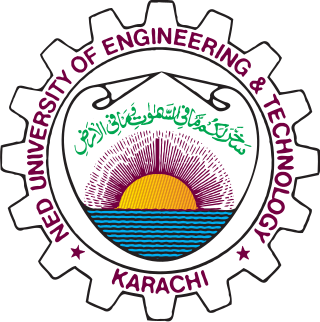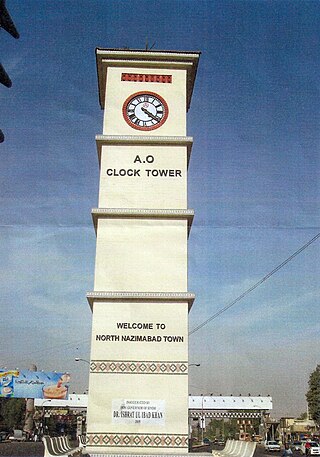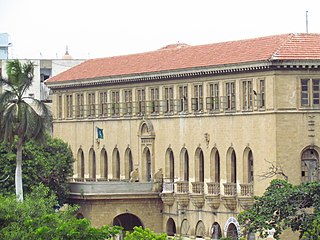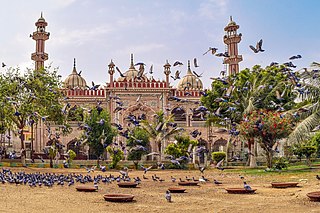
Karachi is the capital city of the Pakistani province of Sindh. It is the largest city in Pakistan and 12th largest in the world, with a population of over 20 million. It is situated at the southern tip of the country along the Arabian Sea coast and formerly served as the country's capital from 1947 to 1959. Ranked as a beta-global city, it is Pakistan's premier industrial and financial centre, with an estimated GDP of over $200 billion (PPP) as of 2021. Karachi is a metropolitan city and is considered Pakistan's most cosmopolitan city, and among the country's most linguistically, ethnically, and religiously diverse regions, as well as one of the country's most progressive and socially liberal cities.

The districts of Pakistan are the third-level administrative divisions of Pakistan, below provinces and divisions, but forming the first-tier of local government. In total, there are 166 districts in Pakistan, including the Capital Territory, and the districts of Azad Kashmir and Gilgit-Baltistan. These districts are further divided into tehsils and union councils.

The University of Karachi is a public research university located in Karachi, Sindh, Pakistan. Established in June 1951 by an act of Parliament and as a successor to the University of Sindh, the university is a "Sindh Government University" and designed by Mohsin Baig as its chief architect.

Saddar, also known as Saddar Bazaar, is a neighbourhood in Karachi, Pakistan. The locality was developed as the primary commercial district during the period of British-era rule in Karachi. As a result, Saddar contains the large concentration of colonial-era architecture in Karachi.

The NED University of Engineering & Technology is a public university located in the urban area of Karachi, Sindh, Pakistan. It is one of the oldest engineering universities in Pakistan, acknowledged for its best teaching practices and graduates.

Karachi Metropolitan Corporation is a public corporation and governing body to provide municipal services in most of Karachi, the capital of Sindh.

North Nazimabad Town lies in the northern part of the city of Karachi, Pakistan, and was named after the suburb of North Nazimabad. North Nazimabad Town was formed in 2001 as part of the Local Government Ordinance 2001, and was subdivided into 10 union councils and North Nazimabad Town was re-organized as part of Karachi Central District in 2015. According to the 2023 Pakistani census, the population of North Nazimabad Subdivision is 920,476.

Saddar Town lies in the Karachi District South that forms much of the historic colonial core of Karachi, in the Sindh province of Pakistan. According to the 2023 Pakistani census, Saddar Subdivision has a population 159,363.

Nanak Wara, originally laid out as the Jail Quarter, is a neighbourhood in central Karachi, Pakistan. The neighbourhood is part of the wider Saddar Town borough, and is located north of MA Jinnah Road. It is situated between Jodia Bazaar and Mithadar on the east, and Gazdarabad on the west. To the south is the Serai Quarter and Aram Bagh.

Muhammad Ali Jinnah Road, frequently abbreviated as MA Jinnah Road, is a major thoroughfare in central Karachi, Pakistan. The road was originally named Bandar Road, because it linked the city to the Port of Karachi, but was later renamed in honour of Pakistan's founder, Muhammad Ali Jinnah. MA Jinnah Road stretches 6.1 kilometres from Jinnah Bridge in the south, near the Port of Karachi, to Gurumandir Chowk, north of Mazar-e-Quaid. It is one of the city's oldest roads, and passes through much of the colonial era historic core of Karachi, with numerous landmarks along its route.

The Malir Cantonment is a cantonment town of the city of Karachi, in Sindh, Pakistan. It serves as a military base and residential establishment.

The Hindu Gymkhana is a colonial-era building located on Sarwar Shaheed Road in Karachi, Pakistan. It was the first public building in Karachi to adopt the Mughal-Revival architectural style. It was established in 1925 by the Karachi's Hindus as an exclusive club for their community. The building houses the National Academy of Performing Arts.
The Ra'ana Liaquat Ali Khan Government College of Home Economics is an all-girls college, established in 1952 in Karachi, province of Sindh, Pakistan. RLAK-CHE is a professional-level college offering numerous highly specialized and technical courses in five different areas of Home Economics – i.e. Apparel & Textiles, Art & Design, Family & Human Development, Nutrition & Dietetics, Residential Management & Entrepreneurship; – including internships and research projects in the senior-most year of studies that are a compulsory requirement for every student graduating from the college.

Aram Bagh, better known as Ram Bagh is a neighborhood located in historic center of Karachi, Pakistan that was built around the Aram Bagh Park. Aram Bagh has a high concentration of listed and protected heritage buildings, with many in a good state of conservation.

Karachi's educational system is divided into five levels: primary ; middle ; high ; intermediate ; and university programs at undergraduate and graduate level.

Nazimabad District, formerly Karachi Central District, is an administrative district of Karachi Division in Sindh, Pakistan created in 1996. According to 2023 Pakistani census population of Nazimabad District is 3,822,325.

The People’s University of Medical and Health Sciences for Women (PUMHSW) is a public medical university located in Shaheed Benazirabad District (Nawabshah), Sindh, Pakistan.
Akhuwat Foundation or simply Akhuwat is a nonprofit organization based in Pakistan, offering interest-free microfinance to individuals who lack access to formal financial services. Founded in 2001 by Dr. Muhammad Amjad Saqib, who serves as the executive director, Akhuwat operates its head office in Lahore and has expanded to over 1,500 cities in Pakistan.

The Dawood Foundation (TDF) is a nonprofit family foundation based in Karachi, Pakistan. TDF has been working in Pakistan since the 1960s and has been heavily involved in establishing various formal and informal education institutions across the country.
The Administrator Karachi is an Officer in the Pakistan Administrative Services, usually of the elite rank of BS-20.


















